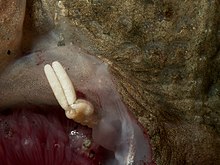Acanthochondria cornuta is a species of parasitic copepod from the northeast Atlantic Ocean, and the type species of the genus Acanthochondria.[1] It infects the gills of several species of flatfish, particularly the European flounder (Platichthys flesus).[2] Copepodids and immature females infect the holobranch of the host, while adult females prefer the pseudobranch and the internal wall, suggesting they migrate upstream in the gills of the host as they mature.[2]
| Acanthochondria cornuta | |
|---|---|

| |
| Scientific classification | |
| Domain: | Eukaryota |
| Kingdom: | Animalia |
| Phylum: | Arthropoda |
| Class: | Copepoda |
| Order: | Cyclopoida |
| Family: | Chondracanthidae |
| Genus: | Acanthochondria |
| Species: | A. cornuta
|
| Binomial name | |
| Acanthochondria cornuta (O. F. Müller, 1776)
| |
| Synonyms | |
|
Acanthochondria depressa (Scott T., 1905) | |
Reproduction
editMales in this species are several times smaller than the females, and attach themselves permanently onto special 'nuptial organs' on their mates. These organs are paired, and therefore a single female can sometimes hold two males.[3] In Portuguese waters, reproduction occurs year-round, and two generations are produced annually: a summer-autumn generation and a winter-spring generation. Females of the former are smaller and produce less eggs, while those of the latter are larger and more fecund but produce smaller eggs.[3]
See also
editReferences
edit- ^ Walter, T.C., Boxshall, G. (2019). Walter TC, Boxshall G (eds.). "Acanthochondria cornuta (Müller O.F., 1776)". World of Copepods database. World Register of Marine Species. Retrieved 19 May 2019.
- ^ a b Cavaleiro, F.I.; Santos, MJ (2011). "Site selection of Acanthochondria cornuta (Copepoda: Chondracanthidae) in Platichthys flesus (Teleostei: Pleuronectidae)". Parasitology. 138: 1061–1067. doi:10.1017/S0031182011000606.
- ^ a b Frade, D.G.; Nogueira, S; Santos, M.J.; Cavaleiro, F.I. (2016). "The challenges of asymmetric mating – the influence of male and female size on the reproductive output of Acanthochondria cornuta (Chondracanthidae)". Parasitology. 143 (14): 1945–1953. doi:10.1017/S0031182016001578.